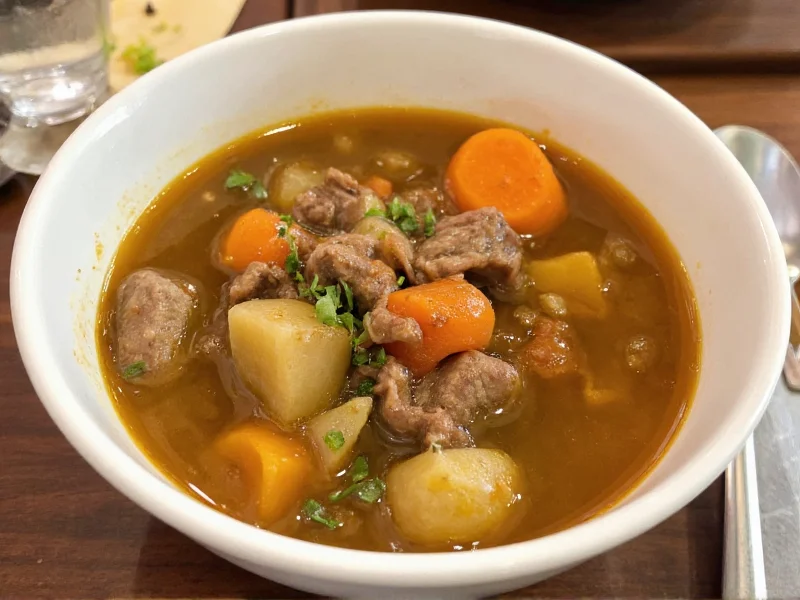Understanding what sets beefy onion soup mix apart from standard varieties helps home cooks maximize its potential in everyday cooking. This versatile pantry staple combines the sweet, caramelized notes of onions with the umami richness of beef broth, creating a flavor foundation that elevates everything from slow-cooked roasts to quick weeknight meals.
What Makes Beefy Onion Soup Mix Different
The primary distinction between beefy onion soup mix and regular onion soup mix lies in its protein-enhanced formulation. While standard mixes focus solely on onion flavor with herbs like thyme and parsley, beefy versions incorporate:
- Dehydrated beef broth or beef fat powder
- Additional savory seasonings like Worcestershire powder
- Higher sodium content for enhanced flavor penetration
- Often includes garlic and black pepper for complexity
This combination creates a more robust flavor profile ideal for meat-centric dishes. When reconstituted with water, it produces a broth with noticeably deeper color and richer mouthfeel compared to regular onion soup mix.
Common Culinary Applications
Chefs and home cooks utilize beefy onion soup mix in numerous ways beyond its namesake soup. The most effective applications leverage its ability to build flavor foundations:
| Recipe Type | Usage Ratio | Flavor Contribution |
|---|---|---|
| Meat marinades | 1 packet per 2 lbs meat | Creates savory crust, tenderizes |
| Gravy and sauces | 1 packet per 2 cups liquid | Deepens color, adds umami base |
| Casseroles | 1 packet per 6 servings | Enhances overall savoriness |
| Slow cooker dishes | 1 packet per recipe | Builds complex broth foundation |
Creating Homemade Beefy Onion Soup Mix
For those seeking to avoid commercial additives or customize flavors, a simple homemade version offers superior control. This basic recipe yields enough for one standard packet replacement:
Basic Homemade Recipe:
- ¼ cup dried minced onions
- 2 tablespoons beef bouillon powder
- 1 tablespoon cornstarch (for thickening)
- 1 teaspoon garlic powder
- 1 teaspoon onion powder
- ½ teaspoon black pepper
- ½ teaspoon paprika
- ¼ teaspoon thyme
- ¼ teaspoon parsley flakes
- 1 teaspoon Worcestershire powder (optional)
Mix all ingredients thoroughly and store in an airtight container. Use one serving (about 3 tablespoons) to replace one commercial packet in recipes. The homemade version allows adjustment of sodium levels and spice intensity to personal preference.
Storage and Shelf Life Considerations
Commercial beefy onion soup mix typically maintains quality for 18-24 months when stored in a cool, dry place. Once opened, transfer to an airtight container to prevent moisture absorption, which causes clumping and flavor degradation. Homemade versions last approximately 6 months under proper storage conditions.
Watch for these signs of spoilage:
- Visible moisture or clumping beyond normal
- Faded color (should be golden-brown)
- Musty or stale odor instead of savory aroma
- Presence of insects or webbing
Smart Substitution Strategies
When beefy onion soup mix isn't available, these substitutions maintain recipe integrity while adapting to pantry limitations:
- For vegetarian needs: Combine regular onion soup mix with 1 tablespoon soy sauce or tamari per packet
- Low-sodium requirement: Use 2 tablespoons onion powder plus 1 tablespoon reduced-sodium beef bouillon
- Gluten-free adaptation: Ensure bouillon is cornstarch-based rather than wheat-derived
- Flavor enhancement: Add ½ teaspoon mushroom powder for additional umami depth
Understanding these substitution ratios prevents recipe failure when your preferred mix is unavailable. The key is maintaining the proper balance of onion flavor, salt content, and savory elements that define the mix's culinary function.
Maximizing Flavor in Recipes
Professional results with beefy onion soup mix come from understanding its chemical behavior in cooking. The dehydrated components rehydrate at different rates, so optimal usage follows these principles:
- Dissolve the mix in warm liquid before adding to recipes for even distribution
- When using in dry rubs, combine with other dry ingredients first to prevent clumping
- Add early in cooking processes to allow flavors to meld with other ingredients
- Balance with acidic components like wine or vinegar to cut through richness
- Reduce additional salt in recipes since the mix contains significant sodium
These techniques transform what might seem like a simple convenience product into a sophisticated flavor-building tool that professional chefs regularly employ for consistent results.











 浙公网安备
33010002000092号
浙公网安备
33010002000092号 浙B2-20120091-4
浙B2-20120091-4